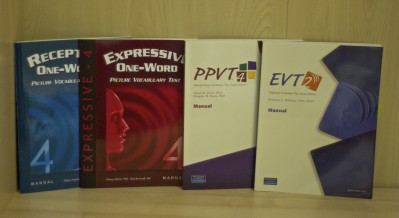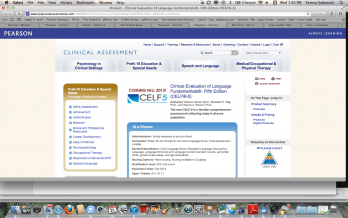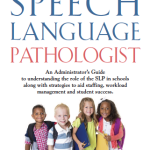SLP Chat
This will be a place where therapists can share ideas, problem solve and express concerns. Lets work together to make our jobs easier!
Teresa
#2 PPVT/EVT vs. ROWPVT/EOWPVT
Last Monday the day after posting my first article on PPVT/EVT vs. ROWPVT/EOWPVT I was reviewing previous testing on a student and couldn’t believe my eyes. Only 3 year ago, a therapist actually used the PPVT/EOWPVT combo when assessing a student. I haven’t seen that in years.
The comparison of the scores was PPVT 84 and EOWPVT 94. General receptive skills fell in the average to below average range and general expressive skills fell almost consistently in the below average range. This is the exact pattern we use to see in the old days. Everything falling quite a bit lower than the EOWPVT.
Now the ROWPVT/EOWPVT was updated in 2011 so perhaps that pattern doesn’t show up anymore. I just thought it was funny to see that right after putting the PPVT/EVT vs. ROWPVT/EOWPVT article together I ran into this.
I’m still curious about what people are using on a regular basis for vocabulary testing and if they like it or not. Please take the time to take the quick 2 question survey.
Thanks
Teresa
Press next to proceed to the survey
This survey is currently disabled.
Coming Fall 2013 CELF-5
I was surfing the web and an ad for the CELF 5 popped up.
http://www.pearsonassessments.com/HAIWEB/Cultures/en-us/Productdetail.htm?Pid=CELF-5&Mode=summary
This is the first I’ve heard about it. Looks like they are making the CELF one stop shopping. Since the CELF is such a good and reliable test to start with I have high hopes for the test. I also hope at $650 they are not pricing themselves out of the market. Lots of budget problems in schools these days. If you have any info on the CELF 5 changes let The School Speech Therapist know.
T
PPVT/EVT vs. ROWPVT/EOWPVT
Unless you are a speech pathologist you probably have no idea what the title is referring do. Well it’s all about vocabulary testing. These tests, with the exception of the EVT have been around for years.
The Peabody Picture Vocabulary Test was originally Published in 1959. It is probably the first test most therapists in training learn to give. Do you believe that back when I was in school we were actually able to calculate something that they referred to as an IQ score. Thank goodness for updates. The test was good even back then and really seemed to reflect the true ability of the student.
The Expressive One Word Picture Vocabulary Test came next in 1979. Everyone started using it almost immediately.
This was the vocabulary testing everyone used for many years, even after the Receptive One Word Picture Vocabulary Test was introduced in 1985. Face it back then schools updated their testing even less frequently than they do now.
This is what we had and this is what we used however, there was always a problem. The Expressive One Word almost always scored significantly higher than than the PPVT. So here we would have a student that scored poorly on the PPVT and just about every other test but on the Expressive One Word his scores would fall significantly higher. Granted parents were glad to see this but we all knew the score on that test gave the wrong impression. It got to the point where I didn’t even bother giving the Expressive One Word any more.
In 1997 the Expressive Vocabulary Test was introduced. It was actually exciting. A companion to the PPVT. You could actually compare the scores and draw conclusions. Smart marketing too, selling them in sets.
Fast forward 10 or so years and I begin working at a school that actually had updated copies of the Receptive and Expressive One Word Vocabulary Test-4. A student came along that was previously tested using the Receptive and Expressive One Word tests so I thought what the heck, I’ll give it a try, then I can report a direct comparison. I honestly don’t think that I’ve ever given the Receptive One Word. I don’t think I ever had a copy available.
The tests were easy to give and less time consuming than the PPVT/EVT combo. However, I just didn’t feel they were meaty enough. It’s hard to explain. I wondered if the Receptive and Expressive One Word tests were actually challenging enough. The student tested actually performed in the low average range on both tests with no gap noted. Their current performance was similar to past performance three years earlier. The ideal comparison for me would be to give both tests to students I know and see how the scores compare. I’d love to know if that study has been done. If you have knowledge of that please let me know.
I love using the PPVT/EVT combo. With almost every student I test I start with those two tests. I not only get information from the scores but their manner of performance. I often base the rest of my testing on that first interaction using the PPVT/EVT. After all my years of dealing with inflated scores in the Expressive One Word it is hard to put my trust in that test. However, there have been several updates and perhaps that flaw has been corrected.
Price wise the PPVT/EVT combo is more expensive but there is less than $100 difference in total cost between the test combos.
So which set of vocabulary testing do you like to use?
Press next to proceed to a two question poll.
Entrance and Exit Criteria
With every job I’ve ever had the administration, in an effort to decrease numbers always wants the speech language pathologists to develop Entrance and Exit criteria. This comes up every few years. Most schools will pull out an old document written in 1988 or so that is apparently their formal E&E criteria. This document is usually very vague and no one even knew it existed. I picture the therapists from the 80ies with big hair and scarves around their necks putting together something to appease the administration and to account for their consulting time together. I also picture one therapist doing most of the work by hand the night before it was due.
I have never worked in a system that “made” the therapists follow their E&E criteria. Still every system thinks this is a good idea. In theory I understand what they are going for and why they want it. Staffing is short, money is tight and we really don’t want kids missing too much class time. However, for administrators to say lets create E&E criteria and think this will solve any of the therapy woes they are sorely mistaken and once again it’s clear that they don’t understand how speech language pathologists function.
When we use standardized testing, specific guidelines have been created within those tests and subtests to determine the child’s level of functioning. This has been done through trials, studies and research in a very formal manner to make the testing reliable. It’s all written in the parts of the manual we don’t usually read. With most of our testing if skills fall below 1 standard deviation of average, the child is suspected of having a disability. Then we use our skills to look at the overall testing to analyze irregularities such as gaps between subtests and other testing, manner of performance during testing, we might look at item analysis to see if there’s a specific patterns, we might compare skills to cognitive ability, we consider other testing and a whole host of things. Today we also look at how students function within the classroom setting and how well they scored on state mandated testing before the team determines services. (Unfortunately these days a kid might not get the service they need if they have been too well trained in how to take state mandated tests and received a good score there or too many kids are pushed toward direct services because they haven’t achieved a good score) Given all those variables and the fact that every child is totally unique, it is almost impossible to come up with specific E&E criteria. As therapists we could come up with hundreds of scenarios where the students did not fit the one standard deviation below pattern, but the kids clearly needed services.
I have read some E&E criteria over the years that says not to pick up a student unless they are 1 1/2- 2 standard deviations below average. I always found that strange since the testing guidelines in the manuals are always clear on what they consider below average. I’ve always interpreted that as the school system saying “all our students are low functioning, you’re nothing special, not low enough.” If that is the case in any school there is something wrong with their curriculum.
I think our Entrance and Exit criteria guidelines are pretty well defined by the tests we give. For a school system to make up their own guidelines that are less strenuous than the ones provided in standardized testing is very arrogant. I would also have to wonder how these decisions would hold up in court if ever questioned.
Below is a very quick survey on Entrance and Exit Criteria. I want to know what other schools use for E&E criteria. I’m hoping to find documents and ideas out there that are different than the ineffective ones I’ve seen over the years.
Press next to proceed to the survey
Out of Range Testing for Severely Impaired Students
This question has come up again? Many therapists are put in positions where they have to test severely involved students who are perhaps not even on their caseload or in outside placements. I know the law says we have to test but how do you do this and make it valid. As far as I know other than some checklists, there is nothing out that that really looks at functional language. I’ve seen the checklists and often you have to modify them to fit the students needs and levels. Then what do the results tell you anyway? There’s usually not cut off to say therapy will be beneficial or not or even guidelines to help you with goals.
Seriously, how do you put an age or level on the language of the severely impaired. There must be a way to describe language or a tool out there that might help. If you have any suggestions please share. I may even consider a short survey to see what others are doing.
Back in February I wrote this article on evaluating out of range students. Some of the suggestions work for me but I’m not sure it is the best way to evaluate. Out of Range Testing for Severely Impaired Students
Survey Says……..(with comments)
Thank you to the Speech Language Pathologists who participated in this speech and language assessment survey. I received responses from 9 people. Granted that isn’t a large number but I’ve read scholarly papers written with less data. I’m using the acronyms in this report since we all know what they are:). Sorry about the comments but I couldn’t help myself. It is my survey so I can do that. Please feel free to share your comments and questions.
What is your standard test battery?
The CELF-4 was the overwhelming test of choice for most therapists. The CASL and the OWLS were most frequently mentioned as second choices. For vocabulary testing most preferred the PPVT/EVT combo to the ROWPVT/EOWPVT. Then there is the good old Goldman Fristoe. What else could you use for articulation? It’s quick, it’s familiar. It’s old but really articulation is the one thing that hasn’t changed.
The tests mentioned for assessing higher order language included the TLC and the TAPS-cohesion subtests. The TOLD and PLS were mentioned for younger students.
What supplementary testing do you use for more involved children or for specific information?
- TOPS
- Parts of the CASL
- CTOPP
- LPT
- TOPL
- Social Language Development Test
- Listening Comprehension
- SSI
- SPELT
- Brigance
I can say that I am familiar with almost all the supplementary testing mentioned on the survey and use several. I prefer the test of problem solving to the TOPL because of the breakdown into skill areas. However, I’ve only read the TOPL not given it. I have the CASL available but just can’t bring myself to take the time to learn something new. I usually fight with the reading specialists on who will give the CTOPP. If you’re smart you’ll let them win. I purchased the Listening Comprehension Test but have yet to use it. I recently viewed a old and copied version of the SSI. Didn’t use it but did use a similar process to gather data. I actually found a great stuttering resource on the State of Tennessee site http://www.state.tn.us/education/speced/doc/71309SLIfluency.pdf Never heard of the The Structured Photographic Expressive Language Test (SPELT) but it sounds interesting and quick to give.
No one mentioned using Test of Written Language, but I read it in reports all the time. Next survey will include that as a question. I personally don’t work with kids enough hours a week to make an impact with their written language, too much follow up is needed to teach the editing process correctly. Plus I feel you have to be able to organize your language orally before there is going to be any significant improvement with writing. Just and opinion.
What drives your test choices?
Most respondents felt that their experience was the main factor when choosing tests to give. A small percentage of the respondents also felt that test availablity, time, administration and curriculum also drove their choices.
Does your school provide up to date testing materials?
Over half of the respondents said that their school does not provide up to date materials. We all know this is a big mistake on the school systems part. I know from personal experience that some school administrators see the importance of this and some don’t. Your testing could be judged invalid if you don’t have up to date or the right materials. Parents are smart these days and don’t hesitate to request an outside evaluation if they don’t feel the assessment at schools is an appropriate one.
Does your school copy protocol sheets?
Approximately 3/4 of the respondents said that sometimes they have to copy protocols and 1/4 said they always have to copy. We all know it happens and it is understandable that you might run out once in awhile. I’ve worked in a few systems where copying was the norm rather than the exception. I don’t know the law but I am assuming copying protocols must violate some copyright law. However, I also know that the protocols I use go into a personal file when testing is over rather than the students file at school.
The other problem with copying is that it makes testing more difficult and time consuming. Often the correct responses are color coded to make life easier. I won’t give up that luxury anymore. During an interview I asked about testing material and protocols. The blatantly told me they copy all their protocols. I blatantly told them (but nicely) that I wouldn’t use copied protocols. We’ll I didn’t want the job anyway.
Do you feel your given enough time to give and produce comprehensive and detailed evaluations?
Not surprisingly the overwhelming response here was a big NO. People not only end up with no writing time, many respondents said that schools also make it challenging to find time to do the actual testing.
How long do you spend testing a student?
Granted this greatly depends on age and specific needs. Respondents specified anywhere from 2-4 sessions ranging from 30-60 minutes a session.
How long do your write ups take?
Write ups take anywhere from 1-6 hours. I should have added a clarifying question on survey. How long is your report? I know my evaluations are usually 6-8 pages in length but much of that is the standard template. One respondent mentioned a short evaluation sheet that they fill out. Length doesn’t necessarily mean quality so I would like to see a shorter form. Maybe even consider using it.
It is clear that expectations for write ups must vary from school to school. I would bet vary from type of community to type of community is more like it. Who your writing for and how much written analysis you have to do shouldn’t but might dictate how thorough you are. I try very hard to do the same for everyone.
Do you have testing time and writing time in your schedule or do you cancel students to get testing done?
Almost 3/4 of the respondents said they had to cancel students to get testing done. Glad to hear I’m not the only one who has had to do that over the years. It’s not the rule but it happens more often than one might think. I hate it and feel extremely guilty because a student had to miss out. Rule of thumb always let the administration know that you have/had to cancel students to get testing done to meet deadline….in writing. they need to know the situation and they need to take responsibility for it.
How many evaluations do you do in a year?
The average seems to be around 30 with a range of 15-40. I know this number can be so random based on caseload size, three year re-evaluation schedules, teacher referrals and parent requests. One year you may have 30 to do and the next year 15. If you have a caseload of 60+ you are doing a lot more. This year I am doing just testing at one of my schools which means I will easily clear, probably 40 evaluations this year.
Do you feel confident and competent when testing and analyzing data?
Almost 3/4 of the respondents said they felt confident with their assessment skills. The other 1/4 said they feel confident most of the time. That’s actually not a bad thing because I feel that leaves you more open minded and willing to learn from others.
Does your testing usually line up with the academic and psychological testing?
Almost 100% of the respondents said yes. I love it when that happens. The team looks so professional.
Feelings about testing
Most therapists preferred to do their own testing because it helps them analyze skills, write goals and plan therapy. Only about 1/8 of the respondents secretly wished that students went out for testing. If I had to guess those feelings are probably related to the report write up rather than doing the actual testing. Only one respondent said they did not like testing. Personally I’d rather write up a evaluation report than a progress report any day.
The report itself
Over 3/4 of the therapists reported using a template or series of templates to make report writing easier. Almost all reported that their reports provided descriptions of the test and what they measure.
The procedure and expectations for making recommendations varied greatly. Some make general recommendations in their report and specific ones at the meeting. Some are required to make recommendations and were cited when they didn’t. I am working in a couple of different systems this year and find that different schools do want it done differently. It guess just depends on who is interpreting the rules and laws. I’d love to find out more about this.
Do Speech Language Pathologists in your district meet on a regular basis and consult?
Most of the respondents stated that they do get together with other therapists in their district. However, not always on a regular basis and with very few relevant common goals in mind. I know that is often administration driven and they tell you what they want you to work on.
Almost all respondents said that they have other therapists in their district that they could consult with. One respondent mentioned approximate 30 SLPs in her district and they felt this was their greatest strength. I would love to know if systems that big have any more power around appropriate caseload/workload, more time for paperwork duties (because of the large numbers or workload) and other issues that only concern SLP’s.
Do you feel teachers value the information you give them and use it in their programming?
Therapists were split about 50/50 on this. Some teachers use the information we provide, some just want the kids identified and one mentioned rarely seeing a teacher take a note during team meetings. I’ve worked in school systems where the teachers present then leave while the rest of us discuss the meat and potatoes of the evaluations and programming. I think they have it wrong. Teachers need to hear what we have to say and learn from us like we learn from them. I think it comes down to our identity in the schools system and few understanding our knowledge and expertise.
Conclusions
Everyone uses a similar battery of tests. The time factor is still an enigma to me. Some take a lot of time to complete testing and some don’t or can’t. I think it is hard to thoroughly judge this since the end products cannot be compared. Perhaps that is a study for another time, “report write ups.” I would like to know if I could do things better and quicker.
Seems like we’re all almost on the same page and we face the same challenges. There is never enough time in our day to complete even the most critical work. Schools don’t seem to understand that when our work is lacking because of time constraints the whole program looks sloppy and unprofessional. I’ve sat in very professional meetings and meetings that were run very inefficiently. There is a difference and some parents do know. I would bet that systems who are constantly battling with parents and/or sending kids out for evaluations, are systems where everything is done on the fly.
This was a fun survey to do and it raised all kinds of questions in my mind. Hopefully I will get to follow up on this in the very near future.
When does a Middle School Child need a Speech and Language Evaluation-reprint
Hi Everyone.
I have to apologize for being so lax about posting. I had the grandest plans for this month, writing about the speech and language assessment process. Well to make excuses, I can tell you that work has exploded. I work part time for a school system doing evaluations and they’ve decided to move up their time line on all of the evaluations. I actually think it’s a great idea but it shoves more work into my limited time. And lets not forget those pesky report write up that mostly take place at home. I also picked up another wonderful part time job at a vocational high school which will be a new experience for me. They too have me testing to meet deadlines.
Since I love evaluating I don’t mind being busy but that leaves little time for other ventures. Today I’m going to recycle a post from last January. It has an evaluation theme so it fits my plan. When does a Middle School Child need a Speech and Language Evaluation
It’s still not too late to participate in my survey on speech and language assessment. Right now I am putting together a report on the data gathered and I can always include more. Assessment Survey
Hope everyone enjoys their weekend. Around here it’s the calm before the storm and we will be securing lawn chairs this afternoon.
Teresa
Easy Report Writing?
Is there such a thing? If you think I have the answer you’d be wrong. You haven’t heard from me in awhile because I am in the throws of report write ups. When you’re a school therapist you don’t have the luxury of clinics who will take months sometimes to write up a report. We have deadlines and they have to be met. However, I am a procrastinator and almost always wait till the last minute to pull things together. Luckily the due dates for the report write up and the actual meeting are usually a few days apart because unlike clinics that drop their reports off at our doorstep, we still have to write up the educational plan in time for the meeting.
Even after so many years of experience report writing is still extremely time consuming for me. I often wonder if I write too much, try to be too specific, write too slow or do too much testing? When I worked a full time school job, I was lucky if I had 2-4 hours in my week devoted to testing. Since it takes at least 2-4 hours to properly test any student and anywhere from 2-6 hours to write up a thorough report, if you have one or more a week, there is a lot of paper work to do at home.
Here are some suggestions to speed up your report write ups.
1. Work From a Template: Take the time to design your own evaluation template. Create a heading. It’s really nice when the whole department uses the same heading it looks more professional. I’ve only worked with a couple of department heads that supported this idea.
a. Arrange your template in a manner that makes sense to you. I personally like reporting test by test rather than by skill. I’ve seen evaluations arranged by receptive subtests and then expressive subtests. I personally find that hard to follow. If I want to compare similar skill areas I will do that in my summary. I find that to be a more organized way to talk about strengths and weaknesses.
b. Make sure your template has only generic information in it. This saves time switching information. I use a filler for the students name to make changing easier. If you’re really efficient have a boys and girls version so your he’s and she’s don’t get mixed up.
c. In my template I have test/task descriptions as initial paragraphs. I may include scoring information and results as part of the template.
d. Tweak your template as often as you need to. This will save time consuming changes when you are writing your report.
e. Make sure charts are uniform. This is my downfall and it looks bad. Over the years I’ve made individual templates for each test, probably in Microsoft. Now I use a mac and the charts are not uniform. A goal of mine this year is to update my charts.
f. It’s always quicker to take away than add. I keep a list of the tests I use frequently in my template. I also have a paragraph explaining the gap when comparing the PPVT and EVT. It’s there if I need it cut out if I don’t.
2. Finding Time: Face it there is never enough time and few realize how time consuming this can be.
a. If you can’t get a long block to write in try to work in blocks of tests or subtests. I found that’s one way that I can get chunks actually completed.
b. If I have to skip over a section because I either don’t have the information or the time to write up a big section, highlight the section you missed. That makes it easy to go back and fill in information.
c. When writing up subtests I often begin thinking of what I want to say in the summary. I use to keep those notes on a separate piece of paper. Now I just quickly scroll down to the empty summary and jot a quick idea.
3. Spend more time and effort on writing a good summary and recommendations: Ultimately, this is the information people want.
a. Right after I look at the test scores my eyes go immediately to the summary. The summary is the section most people are interested in. If they remember anything about your report it will be the summary so make sure that section look and sounds good.
b. Don’t write cookie cutter recommendations. Those are recommendations that are the same for every student. If a school or staff is familiar with your work they will totally not follow your advice if it is the same for every student.
c. Write recommendations that have a good chance of being used in the school setting. This is very good advice especially for outside evaluators. Many time the recommendations suggested by outside evaluators to a school are grandiose and almost impossible to implement in a school setting. That isn’t to say that schools don’t need a push once in awhile or can’t learn new methods. The do and they have to.
4. Don’t over think. Trust your skills: Your professional judgement is probably better than you think.
a. This is another area where I fall short. I am so worried about missing something especially with a complicated student that I spend more time analyzing test results and performance than I should. I do this because I often feel that manner of performance is often as or more important and revealing than test scores or other isolated data. (That of course is a conversation for another day). Never hesitate to comment on manner of performance it adds so much to the evaluation and makes it more personal.
b. Yes we all proof and edit but we are not professional copywriters or editors. We are bound to make mistakes no mater how many times we have proofed and edited. It is embarrassing to find an error in my report during the presentation but it’s occasionally bound to happen. Usually it’s just a simple typo and not a major contradiction which is good. I’ve read other’s reports and they all have the same type of errors.
If I stay organized and of course focused I can cut my writing time a little. However, keep in mind that each child has his own unique learning style and needs. I don’t believe many people other than maybe the school psychologist realize how much work goes into our evaluations. I would love to find a way to pare down my reports without sacrificing testing or information. Is that possible? I really don’t know. If anyone has suggestions I would love to share them on The School Speech Therapist.
Assessing Children Adopted from Abroad
I came across this article on ASHAsphere and wanted to share. The article Relationship and Communication Development in Children Adopted From Abroad by Deborah HWA-Froelich focuses on the uniqued differences in overall language development in children who are adopted from other countries.
I’ve worked with children who have come from other countries who speak both languages in the home and those that acquired english early on after listening and possibly speaking (or beginning to speak) in another language. As Ms. Froelich points out, the foreign adopted children experience a disruption in language development. I know from experienced that these children, when brought to my attention, are clearly more language disabled than the typical ESL/ELL child.
ESL/ELL children have their own set of issues. I see a lot of splinter skills in their vocabulary and comprehension especially if the second language was introduced early, before their native language was firmly developed. However, most typical ESL/ELL students improve and compensate without intensive services. ESL/ELL students usually demonstrate typical pragmatic skill development and interact well in their environment.
We all know that children who are exposed to some type of neglect and abuse are going to have difficulty developing in some if not many ways. This is an added layer, to the development of a child from a foreign adoption that must be considered as part of their profile.
School’s need to be cautious and thorough when assessing the needs of a child from a foreign adoption. Teams will almost always initially assume it is ELL/ESL issue without a complete evaluation. When this happens precious months or years are wasted. I believe the two points made by Ms Froelich, probable abuse/neglect with foreign adopted children (or at least the lack of nurturing at at early age) and the complete disruption in language development are two very valid reasons to conduct a complete Core evaluation on a struggling student with history of foreign adoption.
English is more than likely the dominate language at that point so evaluations should be conducted in English. Look at the child as a language disabled student when planning what test measures to use. If the students are very young when initially tested do not assume that language/learning development will progress as naturally as native speakers. Overall development of foreign adopted children needs to be monitored closely throughout the school years. We know that children who have difficulty acquiring language as young children often experience difficulty down the road with development of higher order language.
When you assess these students do not be surprised at if you see atypical test results. Scores will not fall into the typical patterns you expect, scores may be quite low, scattered and errors will appear throughout many areas of language. Do your best to interrupt the scores and develop a plan. Keep in mind that no matter how enriching their environment is now, these children have missed out and do not have the experiences to draw from to aid consistent development.
Evaluations are Key to Improving Special Education Programs
Many years ago I started a new job in s school district that was rumored to have some problems in their special education department. I was able to confirm the rumors almost immediately. While going through the caseload files I noticed that there were a high number of students who had gone out for their speech and language evaluation. Comparing dates I noticed that the outside speech and language evaluations were either part of the initial request or requested after a speech and language was completed through the school.
Now we have all had this happen. A parent or the team isn’t happy with our findings. This happens when we find problem and when we actually rule out problems. We’re never going to make everyone happy 100% of the time. However, something was different with the pattern I was seeing. There were just too many outside evaluations.
Reading the evaluations, it was easy to see why this happened. The evaluations done by the school speech language pathologist were void or any narrative or analysis. Scores were reported, ranges were given and summaries were sparse. Most of the school speech and language evaluations were 2 pages at best. The quality was poor and no supplemental testing was ever given. I wondered if the therapist was really that bad, never learned the right way to evaluate or just didn’t have time to do the job properly. I wondered how these reports were presented to the parents. Was the therapist able to go into more specific detail in the meetings? The IEP’s didn’t reflect this so I doubted that parents or teachers were given any more information. Basically the evaluations I read raised more questions than they answered.
Parents talk, even in large districts. It only takes one parent or team member to say something negative about a report for that opinion to spread. Pair that with a general lack of confidence in the school’s special education program and you can see how easily a situation like this may occurred. (I’ve seen poor evaluations from clinics and hospitals but somehow it doesn’t seem to sully their reputation as much.)
First Step
With the help of a dedicated staff and a strong team leader this particular school was able to turn around the perceptions of most of the parents. The first step in this process was to improve testing in all areas.
- The school administration supported more testing and meeting time, they were at the point where they realized it was cost effective.
- The team took the time to look over many report styles and picked the best formats and pieces from each one to help develop testing templates.
- Our program manager developed a heading for our written evaluations which immediately gave a more professional and coordinated look to our testing.
- While testing students we collaborated with the other team members. The school psychologist often asked me to dig a little deeper in some areas. I always went to both the regular and the special education teachers to ask them what their biggest concerns were and if there was anything specific they wanted me to try and rule out.
Because of our efforts, we not only looked more professional and coordinated, we were more professional and coordinated. Parents were no longer confused when they left the meeting because everyone had their own different opinions. We did such a good job of coordinating our efforts that we rarely missed anything and our testing almost always dovetailed.
Meetings
The meetings are another key factor to completing good evaluations. When reviewing testing, marathon meetings are a must. It takes a long time to review 3 or more evaluations thoroughly and to develop a good IEP. When schools take the time to answer parent concerns, parents view the schools as caring and personal. Sometimes we actually split the meetings into two if the reports were long and involved, developing the IEP a day or two later (if we had the time legally). This school system was dedicated to improving their evaluation process and hired substitutes so the teachers could stay for most if not all of the meeting. Nothing tells a parent you care less about their kid than leaving a meeting in the middle of it.
With some coordinated team effort and administrative support we were able to turn this particular situation around, keep testing in house and keep costs down. Our testing and our reports became more thorough and looked more professional than some of the previous outside evaluations. In some cases our testing was even better because we often knew the student prior to testing, we were often able to include formal and informal observation, we were able to gather first hand information from parents and teachers to direct testing and we were able to see the kids in a familiar setting over a longer period of time.
Results
Because we collaborated informally ahead of time
- Our recommendations, accommodations and service delivery were truly team decisions.
- We were able to look at all factors such as student need, teacher concern’s, parent’s concerns, other school demands, who would be responsible for accommodations and how to fit the needed services into the students day while developing the IEP.
- Our IEP’s were some of the best and most individual specific I had ever seen.
The outside evaluations often contained recommendations and accommodations. However, they were often generic or grandiose. Suggested service delivery from outside evaluations did not take the schedule, the child’s overall needs or other educational demands into consideration.
I was very proud of the work we did in that school district over the three year period that this particular team worked together. I learned a lot. Watching parents perceptions change and confidence in the school grow was especially rewarding. We knew we had a lot to do with that. Our team leader problem solved and we implemented simple and very common sense changes that made us look good. Best of all the students ended up with an effective IEP. With teachers involved in the process they had an easier time following through on classroom accommodations and modifications. The teachers also knew they could come to us for support.
Did we keep 100% of our testing in house? No of course not but our percentage of in house evaluations shifted significantly with very few evaluations in any discipline completed outside of school. With simple and professional changes we were able to improve the way we did CORE evaluations without a mandate or law. Our team leader took the talents and strengths of smart, caring professionals and gave us the time and tools to improve (not change) our evaluation process. Bottom line we were effective, we looked good and felt more professional.











